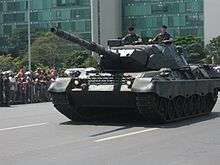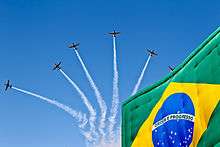Independence Day (Brazil)
| Independence Day Dia da Independência | |
|---|---|
 Independence Day parade in Brasília | |
| Also called |
Sete de Setembro (September 7) Dia da Pátria (Nation's Day) |
| Observed by | Brazil |
| Type | National |
| Significance | The day of the Declaration of Independence of Brazil |
| Celebrations | Parades and concerts |
| Date | September 7 |
| Next time | 7 September 2017 |
| Frequency | annual |
The Independence Day of Brazil (Portuguese: Dia da Independência), commonly called Sete de Setembro (Seventh of September), is a national holiday observed in Brazil on September 7 of every year. The date celebrates Brazil's Declaration of Independence from the United Kingdom of Portugal, Brazil and the Algarves on September 7, 1822.
Origin
In 1808, French troops commanded by Emperor Napoleon Bonaparte invaded Portugal as a retaliation for the Iberian country's refusal to participate in the trade embargo against the United Kingdom. Fleeing persecution, the Portuguese monarchs transferred the Portuguese Court from Lisbon to Rio de Janeiro, then capital of Colonial Brazil. In 1815, Prince Regent John VI created the United Kingdom of Portugal, Brazil and the Algarves, elevating Brazil to the rank of kingdom and increasing its administrative independence.

A political revolution erupted in Portugal in 1820, forcing the royal family to return. John VI's heir, Pedro, Prince of Brazil, remained in Brazil. In 1821, the Portuguese Assembly demanded Brazil to return to its former condition of colony and the return of the heir prince to Portugal. Pedro, influenced by the Rio de Janeiro Senate (Senado da Câmara) refused to return on January 9, 1822, a date which became known as Dia do Fico (I'll Stay Day).
On September 2, 1822, a new decree with Lisbon's demands arrived in Rio de Janeiro, while Prince Pedro was in São Paulo. Princess Maria Leopoldina, acting as Princess Regent, met with the Council of Ministers and decided to send her husband a letter advising him to proclaim Brazil's independence. The letter reached Prince Pedro on September 7, 1822. That same day, in a famous scene at the shore of the Ipiranga River, he declared the country's independence, ending 322 years of colonial dominance of Portugal over Brazil.[1] According to journalist Laurentino Gomes, who wrote a book about the event, Prince Pedro "could not wait for his arrival to São Paulo to announce the decision".[2] Gomes adds that "he was a reckless man in his decisions but he had the profile of leader that Brazil needed at the time, because there was no time to think".[2]
Observance
- Federal law N° 662, issued on April 4, 1949, made Independence Day a paid federal holiday.[3][4]
- Federal law N° 5.571, issued on November 28, 1969, established the protocol for the Independence Day celebration.[5]
Celebration
In Brazil
.jpg)
Independence Day is a national holiday marked by patriotic displays in most Brazilian cities.
In Brasília, the celebration takes place at the Ministries Esplanade with a military parade in the presence of the President of Brazil. Around 30,000 people attend the event each year, which costs about one million reais.[6][7] Similar military and civil parades are held in all the state capitals, and in many cities throughout the country.
The national commemorations are broadcast on cable channel TV NBR. In 2016, in honor of that year's Rio de Janeiro Summer Olympic Games, portions of that city's parade were aired on the channel. It should be noted that until 1959 all national parades were held there as it was the former capital city.
Abroad
In New York City, the Brazilian Day is produced by João de Matos and held annually to celebrate the Independence Day.[8] The event takes place at 46th Street, near Times Square, in Manhattan.[9] The Brazilian Day concert is the centerpiece of the event, featuring famous Brazilian musicians, such as Daniela Mercury, Ivete Sangalo, Chitãozinho & Xororó, Skank, Sandy & Junior, Cláudia Leitte, and Banda Calypso. In 2008, the event drew a crowd of 1.5 million people, according to the New York City Police Department.[8] The Brazilian television network Globo sponsors the event and airs it live to Brazil and over 115 countries through Globo International Network.
Similar events are held in Deerfield Beach, Florida,[10] San Diego,[11] Toronto,[12] Los Angeles,[13] and London, United Kingdom.[14]
Gallery
Independence Day military parade
-

Air show in Brasília, 2005
-

The Presidential Guard Battalion at the parade, 2007
-

Leopard 1A5 main battle tank during the 2009 Independence Day military parade
-
.jpg)
President Dilma Rousseff, in the presidential Rolls-Royce, arrives for the parade at the Ministries Esplanade.
-
.jpg)
The Aerial Demonstration Squadron, popularly known as the Smoke Squadron.
-
.jpg)
1st Guards Cavalry Regiment of the Army, known as the Independence Dragoons.
-
.jpg)
A Boeing C-137 Stratoliner (retired in 2013) followed by four Northrop F-5 jets.
-

The Smoke Squadron
-
.jpg)
EE-9 Cascavel armoured vehicles
-
.jpg)
ASTROS 2020 multiple rocket launchers
-
.jpg)
UAI M1-50 military trucks
-
.jpg)
A KC-130, four A-29 Super Tucano light attack aircraft, and two Mirage 2000 jets
-
.jpg)
VBTP-MR Guarani armored personnel carrier
References
- (Portuguese) "7 de Setembro – Dia da Independência" at the website of the Brazilian Institute of Geography and Statistics
Notes
- ↑ (Portuguese) Sete de Setembro Prefeitura do Rio de Janeiro. Retrieved on 2009-07-05.
- 1 2 Brasil, Ubiratan. "O impetuoso que o país precisava". O Estado de S. Paulo. September 5, 2010.
- ↑ (Portuguese). Lei No 662, de 6 de Abril de 1949. Presidência da República. Retrieved on 2009-07-05.
- ↑ (Portuguese) Decreto Nº 27.048 de 12 de Agosto de 1949. Presidência da República. Retrieved on 2009-07-05.
- ↑ (Portuguese) Lei Nº 5.571, de 28 de Novembro de 1969. Soleis.adv.br. Retrieved on 2009-07-05.
- ↑ Menezes, Leilane. "30 mil pessoas devem assistir ao desfile de 7 de setembro na Esplanada". Correio Braziliense. September 4, 2010.
- ↑ "Festa de 7 de setembro vai custar quase R$ 1 milhão". O Globo. September 2, 2010.
- 1 2 History of the Brazilian Day in NY Brazilian Day in New York. Retrieved on 2009-07-13.
- ↑ The Last Samba of Summer New York Times. Retrieved on 2009-07-13.
- ↑ Brazilian Day Florida Brazilian Day Florida. Retrieved on 2009-07-13.
- ↑ Brazilian Day San Diego Brazilian Day San Diego. Retrieved on 2009-07-13.
- ↑ Brazilian Day Canada. Retrieved on 2010-9-7.
- ↑ Brazilian Day in L.A. Consulate General of Brazil. Retrieved on 2009-07-13.
- ↑ Brazilian Day London Brazilian Day London. Retrieved on 2009-07-13.
.jpg)